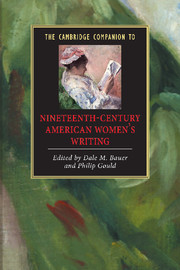Book contents
- Frontmatter
- Introduction
- Part I Historical and theoretical background
- Part 2 Genre, tradition, and innovation
- 4 Captivity and the literary imagination
- 5 Nineteenth-century American women's poetry
- 6 Women at war
- 7 Women, anti-Catholicism, and narrative in nineteenth-century America
- 8 Immigration and assimilation in nineteenth-century US women's writing
- Part 3 Case studies
- Conclusion
- Index
5 - Nineteenth-century American women's poetry
from Part 2 - Genre, tradition, and innovation
Published online by Cambridge University Press: 28 May 2006
- Frontmatter
- Introduction
- Part I Historical and theoretical background
- Part 2 Genre, tradition, and innovation
- 4 Captivity and the literary imagination
- 5 Nineteenth-century American women's poetry
- 6 Women at war
- 7 Women, anti-Catholicism, and narrative in nineteenth-century America
- 8 Immigration and assimilation in nineteenth-century US women's writing
- Part 3 Case studies
- Conclusion
- Index
Summary
The study of nineteenth-century American women’s poetry is undergoing a renaissance. Aside from Emily Dickinson, nineteenth-century female poets were largely forgotten until the archival investigations of the 1970s, when they were rediscovered and examined by several critics. Despite the already extensive effort to reprint women’s poems, write their critical biographies, pioneer new and more useful anthologies, and compile lengthy and inclusive encyclopedias, scholars have only begun to examine critical approaches to women’s poems and the assumptions they bring to bear on reading and teaching women’s writing. What do these anthologies tell us about nineteenthcentury American women’s writing? How should we judge their poetry?
In “Nineteenth-Century American Women Poets Revisited”(1998),Cheryl Walker contends that women’s writing contains more stylistic variety and vocal complexity than previously ascribed. In The Nightingale’s Burden (1982), she identifies several persistent types of poems: the “sanctuary” poem, in which the protagonist finds freedom in a shelter; the power fantasy; the “free bird” poem, in which the speaker identifies with a bird in flight and symbolically imagines freeing herself; and the marriage poem. Although her essay still identifies generic features in women’s poems, Walker advocates dividing women’s poetry into four temporal and stylistic categories: early national, romantic, realist, and modern. Early national poets, like Lydia Sigourney, appeal to piety and reason, praise decorum, and base their belief in human dignity on democracy.
- Type
- Chapter
- Information
- Publisher: Cambridge University PressPrint publication year: 2001
- 1
- Cited by



